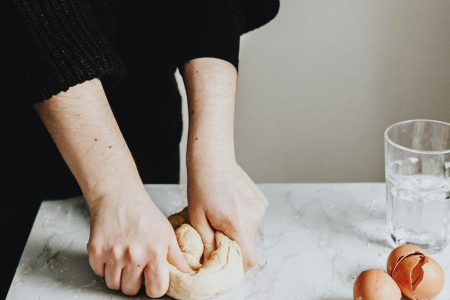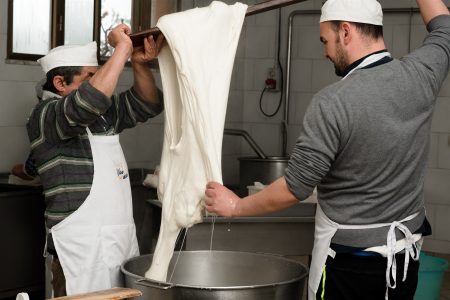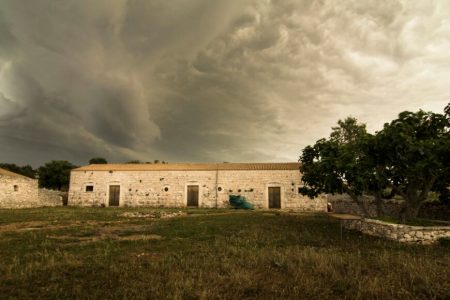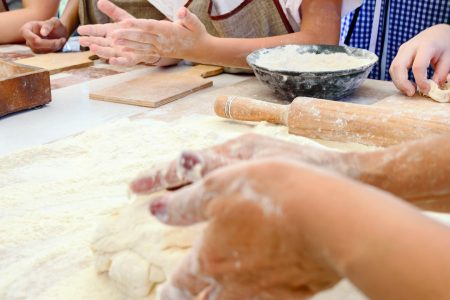Table of Contents
In South Italy during muggy summer days it is customary to enjoy the frisella, a simple and delicious baked good typical of the food and wine tradition of the southern regions, similar to bread but with a flattened shape and hard texture that characterizes it. Originally, the frisella, accompanied sailors on their long voyages then became fully part of the tradition of the South. To this day it differs among the different regions of the South in appearance, texture and flavor. The one we find in Naples is not a simple frisella but the fresella Neapolitan.
The ancient origins of Frisella
L'source of the frisella is very old indeed. It first came on the scene, dating back to the 10th century B.C., at the time of the long voyages of navigators Phoenicians. In fact, during their travels, they used to consume this special type of bread which, being biscuit-like, could be stored for a long time.
According to other scholars, however, frisella was also known to Greek and Cretan peoples. Other historical evidence for frisella comes from the writings of Pliny the Elder who mentions it in his Naturalis Historia, book XXII. Indeed, it seems that this food was also known to the Romans and that the term fresella is actually derived from the Latin word "frendere" meaning "to grind, pound, reduce into pieces."
In the story more recent, the frisella then begins to differentiate itself. Before the postwar years, the dough was prepared using different types of flour. With durum wheat flour a more expensive frisella was obtained, consumed during celebrations or otherwise widespread on the tables of the well-to-do. In contrast, friselle made by kneading barley flour or from mixtures of wheat and barley were cheaper and thus generally consumed by the lower classes.
In the tradition of Southern Italy, at the time when poverty was widespread, it was customary to bake all baked goods for the entire community by means of huge and capacious public ovens. Baking took place two or three times a month with the use of large quantities of dough that had to guarantee the daily food needs of all families.
The smallest part of the dough was destined for the production of loaves of soft bread, to be consumed in the short term while with the larger part was proceeded to the production of biscuit bread, precisely the friselle stored then in large stone jars.
Currently, friselle can be found at supermarket food counters and local delis, where they are sold bagged, in various sizes and made from a variety of flours and blends.
You might be interested
Cooking class with appetizer and lunch to learn how to make orecchiette pasta
per person Book
Fior di latte experience and tasting of typical products in Vico Equense
per person Book
Visit with tasting at Alta Murgia National Park to learn about silvopastoral activities in the area
per person Book
Cooking Class dedicated to pasta in Salerno
per person Book
The fresella of Naples and Campania
In the region Campania, specifically in the city of Naples, friselle, locally called freselle, were once sold exclusively by the "tarallaro," a street vendor who sold precisely taralli and the freselle. With this very special "bread" here we prepare the caponata, one of the typical local dishes: fresella is soaked and seasoned with chopped fresh tomatoes, garlic, oil, oregano, basil, white or black olives and tuna or anchovies, also known as salted anchovies.
Traditionally, fresella was also used as an accompaniment to the typical Neapolitan dish salsicce e friarielli. A Benevento, an inland location in Campania, instead fresella is prepared with a dough with "nzogna and pepper" and enjoyed as is as an accompaniment to sliced meats and appetizers especially during the Easter.
In Amalfi Coast Instead, one finds vascuotto, a product that bears the De. Co. mark. , of municipal designation, typical of the locality of Agerola and of the Lattari Mountains. According to Agerola tradition, the dough for this particular type of frisella, is prepared with water, salt and a mixture of wheat and rye flour, a variant that has coarser and more savory grains.
Only criscito or sourdough starter is used to make the dough, which can also be made from corn and wheat flour. The term vascuotto, comes from the elongated conformation of the dough strand.
The frisella of Apulia
In Apulia the frisella is called the bread of the Crusaders since due to its long shelf life it represented one of the main foods of Christian troops during the long journeys of the Crusades. Its doughnut shape also meets specific needs: presenting the typical central hole, in fact, the freselle were threaded one after the other and joined together by a string. With a knot then the ends of the string were joined so that they could then be carried comfortably or stored dry, decreasing any moisture as much as possible.
Today, Salento's durum wheat friselle, commonly called frise or friseddhe, are a typical dish of Apulia and a very special utensil was also invented for their preparation: the "sponza-frise." This is a very special terrine, made from Grottaglie pottery, covered at the top with a half dish with holes. A practical and elegant invention to rehydrate the frisella with the so-called "sponzatura."
By dipping the biscuit bread doughnut in water, in fact, care must be taken so that the product is evenly rehydrated to avoid the presence of unpleasantly hard areas. A frisella that is not "sponzata" properly will be bitten with difficulty with a disastrous collapse of the filling placed on the surface. Traditional Salento frisa can be seasoned with extra virgin olive oil, fresh tomato and oregano and possibly an addition of fiordilatte and cucumber.
In Bari, frisella is a culinary specialty, also served in restaurants under the dialect term cialdèdd', cialdella or waffle that is also very often prepared at home and then sold in stores. The preparation involves the use of oil, water, fresh tomato sauce and wine, while artichokes and lampascioni, a particular type of garlic, are used for the sinful seasoning.
Fresella in Calabria
Regarding the toe of the boot, in Calabria, the frisella takes on the name fresa. In this Calabrian variant, the undisputed local queen could not be missing: the Tropea onion.
The milling cutter calabrese, is prepared by rubbing a clove of fresh garlic directly on the surface of the biscuit bread, even before softening it by moistening it with water. Meanwhile, cubes of fresh tomato, slices of Tropea onion and the Calabrian chili pepper seasoned with a drizzle of extra virgin olive oil are prepared in a bowl. Everything will then be arranged directly on the fresa, sprinkling with oregano.
How to make frisella, the bis-baked bread
As we have already mentioned, there are several variants of frisella, which is still prepared by means of a dough made from barley and durum wheat flour or other types depending on the desired taste, salt, yeast and water.
The frisella is baked twice: the first time to bake the shapes, which while still hot will be divided into two halves on the horizontal plane, with the help of a "choke" wire. It is this operation that will give each frisella the typical wrinkled surface that characterizes its appearance. The pieces obtained, will then have to be placed back in the oven where cooking will be finished, which is why the frisella is called bisque bread, that is, cooked twice. In the cold evenings ofwinter can enrich soups made with vegetables, fish, meat, or legumes or can be used as a base for side dishes or, according to tradition, in place of bread.
Neapolitan freselle recipe
Ingredients for six freselle:
- 400 g of flour
- 1/2 cube of yeast (if it is winter, better to use a whole one)
- 1 level teaspoon of salt
- lukewarm water to taste.
Preparation
First dissolve the yeast in warm water. Then put the flour in a bowl and gradually add the dissolved yeast, then knead all the ingredients adding the salt at the end. Knead the dough for about 10 minutes until smooth and homogeneous and let it rest for 20 minutes.
Once rested divide the dough into loaves of about 200 g and create wide, flattened doughnuts that you will let rise for another 20 minutes. When they have risen, bake them in the oven at about 160°. Then take them out and when they are cold (since surely it would be difficult to do this when they are boiling hot as in the case of the bakeries with the "choke" wire) divide them in half obtaining the typical fresella shape and bake them again for another 15-20 minutes until they are dry.
Once cooked, it is a good idea to let them cool covered with a breathable cloth and then store them in bread bags. Now all that remains is to taste!





0 Comments